#18th century erasure
Text
Book review: Chinese Wallpaper in Britain and Ireland (2017) by Emile de Bruijn

*I wrote this last year but completely forgot to post it. Enjoy the old stock :)
I’ve seen a lot of interesting images from this book on Pinterest so I decided to get the real thing, and I have to say I am extremely satisfied with it. This book is about Chinese made wallpapers from the Qing Dynasty (mostly 18th and early 19th centuries) that were exported to Europe and used as decoration in British and Irish homes. Although wallpapers are an interesting subject on their own, I will only be reviewing it only on the basis of how useful it is for fashion history research. This will be a short one.
Great images
Apparently I was not the only person who got this book for the pictures as the review at the back of the book suggests, and I fully understand why. This book contains high quality photos of Chinese wallpapers from the 18th and 19th centuries, in perfect resolution and colors. Even if you’re not interested in Chinese fashion, I would still recommend you to get this book because it also shows beautiful antique British and Irish interiors and chinoiserie wallpapers, and is just plain pleasant to look at.
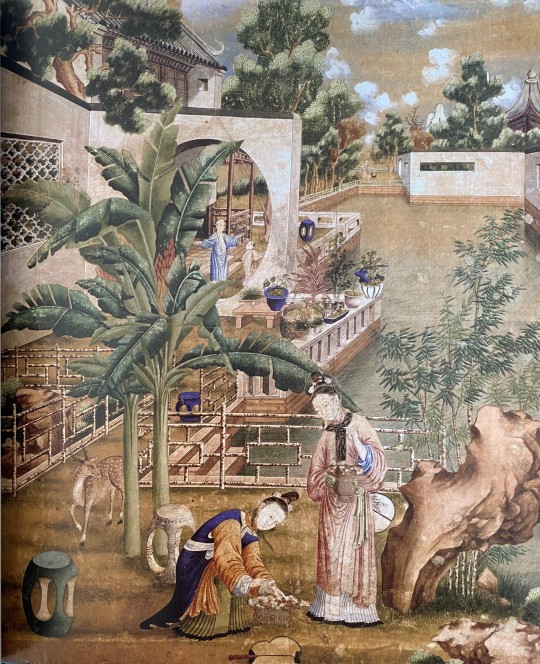
One of my favorites from the entire book, a full page spread with delicious details of a wallpaper depicting a Chinese garden using linear perspective. Even better that the ladies are clad in Qianlong era garments.
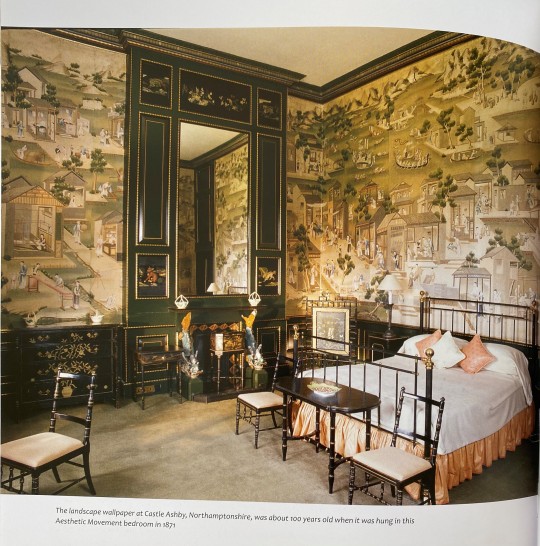
Photos of interiors are also immaculate.
The importance of commercial art
Commercial art like wallpapers, portraits and export paintings is very marginalized in the study of Chinese art, so I highly appreciate that this book sheds more light on a category that traditionally finds absolutely no favor with Chinese art historians. Because of commercialization and increased trade with Europe, popular artworks from this era that depicted life realistically often employed Western painting techniques at least to some extent, meaning they don’t look very Chinese and are often neglected by scholars; more stereotypically Chinese literati painting genres, such as landscape painting or 仕女画 shinvhua (idealized paintings of women) are definitely way more popular among art historians.
Literati painting seldom, if ever, depicted people’s clothing realistically. Costumes were meant to be excessively flowy, adhering to people’s imagination of deities and supernatural beings. Sometimes hints of contemporary fashion could be seen if you know what to look for, because the artist’s imagination had limits and they couldn’t just pull an outfit out of thin air. But still, literati paintings should never be used as resources for the study of fashion history, because the clothing shown had little to no connection to what was popular in real life. Commercial art, on the other hand, depicted real people with real fashion, but is seldom shown in museums or books on Chinese art history because it was considered vulgar and inferior by the literati upper class. In my opinion, commercial art is miles more interesting than literati painting, because literati art has changed relatively little over the course of Chinese history due to conservative Confucian morals, whereas commercial art was usually more reflective of their time and popular tastes. The only non literati Qing painter to ever receive mainstream attention was probably Castiglione, but he was also a court painter and didn’t belong in the commercial category. Even Lam Qua is niche. The commercial export paintings made by native middle class artists of the Guangzhou thirteen factories (十三行), who had more freedom and pioneered new art forms (like reverse glass painting), are rarely discussed.

Literati painting attributed to 焦秉贞 Jiao Bingzhen (active 1689-1726). The costumes of the women, which are extremely stylized and historicist, follow rules of the genre established centuries ago and do not reflect actual fashion. Jiao could paint in the Western style as well, I’m just picking a shinv piece he did. This is the type of stereotypically Chinese art historians love to focus on.

From Chinese Wallpaper, likely made in the late Qianlong era (1770s-1790s). This kind of more down to earth art illustrating everyday life is a lot more rare to see, especially those where the artist attempts Western shading or perspective.
Because “Chinese art” for most people only encompasses literati painting, calligraphy, ceramics and other such stereotypical disciplines, seeing the relative lack of them in the Qing it’s easy to jump to the conclusion that art was not produced with the same rigor as in previous dynasties, which then leads to notions about the Qing being conservative and uncultured and such. No, art was abundant in the Qing, it’s just that the popular taste in art has changed so it was often made in a different medium (oil painting, print and indeed wallpapers) using a combination of Chinese and Western techniques. Scholarship on mediums like oil painting (China trade painting) and reverse glass painting has been virtually nonexistent until very recently; the first thorough monograph of reverse glass painting I’ve read is Thierry Audric’s 2020 Chinese Reverse Glass Painting 1720-1820. I really hope that as research on Qing export art accumulates, it would be able to finally integrate itself into the wider timeline of Chinese art history. So on this matter, thank you de Bruijn for making a whole book on a niche category of Chinese art.
Underrated era
Now with the context out of the way, I can talk about fashion. Although there is no mention of fashion in the text since that isn’t what this book is about, the images included are great for illustrating fashion in the early to mid Qing, which is not well represented in the study of Chinese fashion history at all. I’ve talked multiple times about 18th century erasure on this blog, and I think this book is a very good antidote to that. The bulk of the wallpapers featuring humans were from the Qianlong era (1735-96), a personal favorite era of mine, and there are also several that depict the Jiaqing era (1796-1820), which is even rarer.
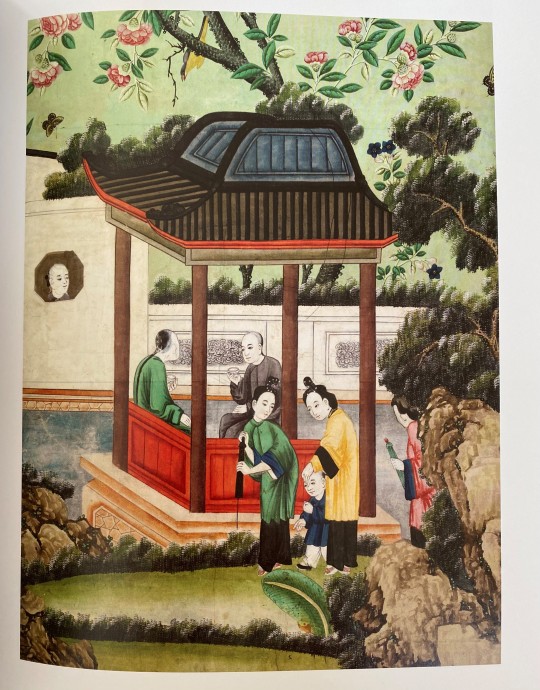
What seems to be Jiaqing era clothing. The unicolor robes with black binding paired with plain black pants or skirts have a very casual and pastoral look. The style is weirdly reminiscent of modern stereotypical “Republican era uniform” Halloween costumes, but way better.
Conclusion/rating
This is a short review because the main point is that this book has plenty of nice images of an underrated era. Without a doubt 9/10. One point off because it would be nicer if the wallpapers are dated, but that’s a minor qualm.
262 notes
·
View notes
Text
I’m just frustrated at the erasure of the association between fashion and gender nonconformity (and by extension homosexuality) in the 18th century. This isn’t to say that class played no role but to say that for men caring too much about fashion had no connotations of effeminacy and homosexuality is just factually incorrect. I have to ask why do people get so upset when I point out that macaroni fashion was considered gender nonconforming? Or when I say fop, dandy and namby-pamby were insults aimed at effeminate men? Why are you upset when I point out that poor femme men have always existed?
#I might delete some of the posts cause I was in a bad mood when I wrote them and was being a bit rude#but my point stands about fashion and gender nonconformity
144 notes
·
View notes
Text
youtube
Watch the American Climate Leadership Awards 2024 now: https://youtu.be/bWiW4Rp8vF0?feature=shared
The American Climate Leadership Awards 2024 broadcast recording is now available on ecoAmerica's YouTube channel for viewers to be inspired by active climate leaders. Watch to find out which finalist received the $50,000 grand prize! Hosted by Vanessa Hauc and featuring Bill McKibben and Katharine Hayhoe!
#ACLA24#ACLA24Leaders#youtube#youtube video#climate leaders#climate solutions#climate action#climate and environment#climate#climate change#climate and health#climate blog#climate justice#climate news#weather and climate#environmental news#environment#environmental awareness#environment and health#environmental#environmental issues#environmental justice#environment protection#environmental health#Youtube
7K notes
·
View notes
Text
Elizabeth S. Hamilton at the Constitutional Convention, June 1797
Elizabeth Schuyler attended a diplomatic meeting at the age of 6; as a teenager, she hosted politicians solo; her relationship with George Washington predates Alexander Hamilton's. As a married adult, she stood in for Martha Washington, she led the Republican Court in NYC, she led charitable endeavors, and she hosted any number of national and international figures, from bankers to politicians, etc. U.S. presidents through the 1840s paid homage to her. But as so many women of the early Republic were, she was pretty deliberately erased. Particularly excised were the contributions and political activism of the Federalist wives - the amount of influence these women had could not be discussed.
And so by the late 20th century, we have historians writing that ESH didn't like politics and was sickly, usually pregnant, and often absent from her husband, but at least she tried to make a nice cozy environment for the Great Alexander Hamilton to go home and snuggle in, or something like that, as though it didn't occur to these historians that Elizabeth Schuyler likely could have married any number of wealthy, accomplished (and distant relative) men and lived a very comfortable life of luxury in Albany. And yet she looked at the super-charismatic guy who everyone said was brilliant, but with no steady income, not even a lawyer yet and with no ties to Albany, but noted as highly ambitious and said, "yep, he's the one!" Spoiler: she did it because she was ambitious herself and recognized that theirs could be a strong strategic/political partnership, in addition to a strong marriage. (I'm sure it was also good for her ego that he declared himself her best friend after only a few weeks and was so far gone he couldn't remember a military password after an evening with her.)
This erasure led to the common assumption that Elizabeth was not in Philadelphia at the Constitutional Convention in summer 1787. However, statutesandstories.com has posted about new evidence - really, a more careful examination and reading of old documents - that ESH was in Philadelphia in June 1797, and was likely in the city at the time of AH's June 18th speech to the convention. The theory is that she traveled with the Knoxes from NYC to Philadelphia, as she's mentioned in a letter from Knox that she is traveling with them, and she's definitely with AH on June 19th, as they are recorded in a journal/diary at a social engagement also attended by George Washington. Additional conjecture that this letter from AH can be more tightly dated to this period, considering these lines:
I cannot yet determine what will be our stay here and consequently I can make no determinations about my love; but I feel that it will be impossible for me to submit to a long separation however inconvenient it may be to incur the expence which will attend her coming here.
Which may align with EH borrowing money for this travel from her brother-in-law, Stephen van Rensselaer, also possibly more tightly dated to this period.
Please check out the well-cited posts (3 parts): 1, 2, and 3
Although no Hamilton biographers have discussed Eliza’s trip to the Convention in June, historians from Independence National Historic Park (INHP) concluded in the 1980s that Eliza was one of as many as nine wives who likely “attended” the Convention. Part 4 (pending) will discuss Eliza Hamilton’s relationship with the other eight wives who likely were in Philadelphia during the Convention, including Rufus King’s wife, Mary Alsop King, who was a native New Yorker.
This makes total sense to me - not just the documentation presented, but that she would have shown up to perform soft politicking/diplomacy around her husband's activities, in addition to a possible role assisting him in the drafting and editing of his speech. The daughter of Philip Schuyler and Catharine Van Rensselaer wasn't going to sit in NYC on the sidelines for this - she bolstered Hamilton not only in the ways she was personally helpful to him (emotionally, but also going over his writings and speeches with him), but through her representation of the wealthy Dutch-American interests, showing that Hamilton was a junior delegate from NY with a lot of political and financial power backing him.
As the blog states:
Yet it remains possible that Eliza may have helped her husband prepare for his one-of-a-kind speech on June 18. Moreover, it is felt that the possibility of informal, behind-the-scenes contributions by Eliza cries out for further examination.
Cause ya know, she's not discussing new threads for her needlework and thoughts on child-weaning at all these social gatherings or standing in for Martha Washington and chatting with Martha's husband about the best ways to make pastry.
And I just love if she helped advise him on a speech that only the "rich and well-born" can make a strong government. I'm sure they felt quite haughty and proud and said, "let's make another baby!" (James Alexander Hamilton was born around 9 months later.)
13 notes
·
View notes
Text
At the National Opera of Ukraine in Kyiv recently, I watched a performance of an opera by the Ukrainian composer Mykola Lysenko. The work, charming and comic and an escape from the grimness of Russian missile attacks, is called Natalka Poltavka, based on a play by Ivan Kotliarevsky, who pioneered Ukrainian-language literature in the late-18th and early-19th centuries. Operas by Verdi, Puccini and Mozart, and ballets such as Giselle and La Sylphide, are on the playbill, despite the almost daily air raid sirens. But there is no Eugene Onegin in sight, nor a Queen of Spades, and not a whisper of those Tchaikovsky staples of ballet, Sleeping Beauty or Swan Lake. Russian literature and music, Russian culture of all kinds, is off the menu in wartime Ukraine. It is almost a shock to return to the UK and hear Russian music blithely played on Radio 3.
This absence, some would say erasure, can be hard to comprehend outside Ukraine. When a symphony orchestra in Cardiff removed the 1812 Overture from a programme this spring, there was bafflement verging on an outcry: excising Tchaikovsky was allowing Vladimir Putin and his chums the satisfaction of “owning” Russian culture – it was censorship, it was playing into Russia’s hands. Tchaikovsky himself was not only long dead, but had been an outsider and an internationalist – so the various arguments went. It took some careful explanation to convey that a piece of music glorifying Russian military achievements, and involving actual cannons, might be somewhere beyond poor taste when Russia was at that moment shelling Ukrainian cities – particularly when the families of orchestra members were directly affected.
In fact, such moments have been rare in western Europe. Chekhov and Lermontov continue to be read and Mussorgsky to be performed. Russian culture has not been “cancelled” as Putin claims, and Russian-born musicians and dancers with international careers continue to perform in the west – assuming they have offered a minimum of public deprecation of the killing and destruction being visited on Ukraine. Only the most naive would decry the removal of Valery Gergiev from international concert programmes. The conductor, who is seen as close to Putin, backed the Russian annexation of Crimea in 2014 (unrecognised by most UN countries), has declined to condemn the current full-scale invasion of Ukraine, and has a history of using his artistic profile in the service of the Russian state, such as conducting concerts in Russian-backed South Ossetia in 2008 in the wake of the Russo-Georgian war.
Inside Ukraine, though, things look very different. For many, the current war with Russia is being seen as a “war of decolonisation”, as Ukrainian poet Lyuba Yakimchuk has put it – a moment in which Ukraine has the chance to free itself, at last, from being an object of Russian imperialism. This decolonisation involves a “total rejection of Russian content and Russian culture”, as the writer Oleksandr Mykhed told the Lviv BookForum recently. These are not words that are comfortable to hear – not if, like me, you spent your late teens immersed in Tolstoy’s Anna Karenina and Chekhov stories; not if you have recently rekindled your love of Russian short fiction via George Saunders’ luminous book, A Swim in the Pond in the Rain; not if you adore Stravinsky and would certainly be taking a disc of The Rite of Spring to your desert island.
The context for this rejection has to be understood, though: Ukrainians are emerging from a history in which the Russian empire, and then the Soviet Union, actively and often violently suppressed Ukrainian art. This has worked in a number of different ways. It has included the absorption of numerous Ukrainian artists and writers into the Russian centre (such as Nikolai Gogol, or Mykola Hohol in Ukrainian), and the misclassifying of hundreds of artists as Russian when they could arguably be better described as Ukrainian (such as the painter Kazimir Malevich, who was Kyiv-born but Russian, according to the Tate). It has meant that writing in Ukrainian has at times been proscribed – Ukraine’s national poet, Taras Shevchenko, was banned from writing at all for a decade by Tsar Nicholas I. This silencing has encompassed the extermination of Ukrainian artists, like the killing, under Stalin, of hundreds of writers in 1937, known as “the executed renaissance”. Behind all of this stands horrific events such as the Holodomor, the starvation of about 4.5 million Ukrainians in 1932-33 in their forced effort to produce grain on Stalin’s orders.
This history places Ukraine in a very different position in relation to Russian culture than, say, Britain found itself in relation to German and Austrian art during the second world war, when Myra Hess programmed Mozart, Bach and Beethoven in her National Gallery concerts during the Blitz. “We have had cultural occupation, language occupation, art occupation and occupation with weapons. There’s not much difference between them,” the composer Igor Zavgorodniy tells me. In the Soviet period, Ukrainian culture was allowed to be harmlessly folksy – and Ukrainians, caricatured as drunken yokels dressed in Cossack trousers, were often the butt of belittling jokes. But Ukraine was not expected or allowed to carry a high culture of its own. At the same time, Russian artistic achievement was lauded as the very apex of human greatness. “We were raised in a certain piety towards the Russian literature,” explains the playwright Natalya Vorozhbit, who was educated in the Soviet period. “There wasn’t such piety towards any other literature.”
Putin himself has effectively doubled down on all this through his constant insistence, in his essays and often rambling speeches, that Ukraine has no separate existence from Russia – no identity, no culture at all, except as an adjunct of its neighbour. Indeed, his claim of Russia’s cultural inseparability from Ukraine is one of his key justifications for invasion. At the same time the Russian instrumentalisation of its artistic history is breathtakingly blatant. In occupied Kherson, billboards proclaiming it as a “city with Russian history”, show an image of Pushkin, who visited the city in 1820. Ukrainian artists also object to how, in a more general way, the projection of Russia as a great nation of artistic brilliance operates as a tool of soft power, a kind of ambient hum of positivity that, they would argue, softens the true brutality of today’s invasion. In Ukraine, there is a generalised cry of “bullshit” in relation to the myth of the “Russian soul”.
Some Ukrainians I speak to hope that one day, beyond the end of the war, there will be a way of consuming Russian literature and music – but first the work of decolonisation must be done, including the rereading and rethinking of classic authors, unravelling how they reflected and, at times, projected the values of the Russian empire. In the meantime, “My child will be perfectly all right growing up without Pushkin or Dostoevsky,” says Vorozhbit. “I don’t feel sorry.”
For many Ukrainians I encounter, the time for Russian literature will come again – when it can be critically understood as simply another branch of world culture, and as neither an unduly oppressive, nor overwhelming, force. At the National Opera House, I ask the choreographer Viktor Lytvynov when he thinks Tchaikovsky – a composer he loves – will be back on the programme. “When Russian stops being an aggressor,” he says. “When Russia stops being an evil empire.”
70 notes
·
View notes
Text
The Moroccan cemetery fighting oblivion
Because of a tradition that held only descendants of a deceased family member could locate their grave, it was a miracle that the tombs of three distinguished rabbis in the Tetuan Jewish cemetery were discovered after a 60-year search. Jacob Marrache and his cousin are running a campaign to restore the cemetery, he tells JNS reporter Georgia Gilholy in this profile of the near-extinct community in the former Spanish protectorate on the north Moroccan coast. (With thanks: Imre)

The Tetuan Jewish cemetery (photo: Alberto Hayon)
Marrache and his distant cousin, Andrew Strum, an Australian judge, have raised more than $3,000 of a target of nearly $11,000 to restore Tétouan’s Jewish cemetery, whose name, Cementerio de Castilla, recognizes the fact that Jews were first buried there after being expelled from the Iberian kingdom in 1492.
“My family left Morocco for Gibraltar in 1758, but like many Jewish families, we kept close contact with Tétouan for many generations, as different communities would look to one another for halachicguidance,” Marrache said.
“We even call Tétouan ‘Pequeña Jerusalen’ [‘Little Jerusalem’] because of its former significance as a center of Sephardic life,” Alberto Hayon, the community’s president, told JNS.
Only about a minyan of Jews live in the area of the cemetery now, according to Marrache, who calls Hayon “a real trailblazer.”
“He spearheaded these restoration activities and founded the charitable association overseeing them,” Marrache said. “We hope they will one day result in a full museum.”
Morocco’s Jewish community dates back to antiquity. By 1948, there were about 270,000 Jews living there. That number plummeted to an estimated 2,300 Jews as of 2015. Experts are still piecing together the fractured memories left behind, and the fact that many of the tombs, which line the slopes of Mount Dersa, lack inscriptions compounds the erasure of prior Jewish communities.
“The tradition was that if somebody was married and had children, they wouldn’t put a name on the grave because it was a duty of their descendants to teach the next generations where ancestors were buried,” Marrache said, “and to return there on the date of their death.”
Many tombstones have Jewish symbols, such as Stars of David or Trees of Life, including on the tombs of rabbis.
“The six-pointed star probably did not have the same meaning as today’s Magen David star, which only became a major Jewish symbol in the Habsburg Empire,” explained Marrache. “A lot of the tombs also have the Tree of Life on them.”
Other stones, which originated in Spain and are rarer in Morocco, are shaped like the contours of a person, according to Marrache.
In 1956, Morocco declared independence from France, suspending Jewish immigration and travel abroad. When Moroccan Jews again had the right to emigrate in 1963, more than 100,000 moved away, largely to Israel. As the community gradually dwindled, knowledge of the locations of the tombs of the three rabbis seemed to have been lost.
Marrache has “long been aware” of a rumored tradition of the community praying at the tombs of the three on the eves of Rosh Hashanah and Yom Kippur.The cemetery in Tétouan in northern Morocco, where the tombs of three celebrated 17th- and 18th-century rabbis — Jacob Ben Malca, Hasday Almosnino and Jacob Marrache — were rediscovered after more than 60 years. Credit: Alberto Hayon.
“My seventh cousin Andrew Strum heard this firsthand from relatives in the 1980s who had left Tétouan for Israel in the 1960s,” he told JNS. “For years, my family members have wanted to find the tomb of Rabbi Jacob Marrache, and in early 2000, we sent someone to check in Tétouan, but there was no one who could find it.”
There have also been “false starts” in recent years, noted Marrache. Some even remembered the tradition but couldn’t locate the tombs.
Hayon told JNS that Rabbi Joseph Israel, a Tétouan native who now lives in Casablanca, helped provide the breakthrough.
“He remembered this tradition well and during Purim this year, he visited and gathered the strength to walk up the cemetery,” where he showed the community the three graves, Hayon told JNS.
But that place, where several elderly people recalled going, is steep and has become “very overgrown, making it quite difficult to reach,” he added.
Various historical documentation also backs up this year’s discovery, including the writings of former Knesset member Rabbi Shlomo Dayan, who recorded that the community’s leader (the late uncle of today’s “trailblazer”) had shown him the tombs of Almosnino and Marrache in 1993. Writings in the 19th century also recorded visiting those graves.
And in 1955, Haim Ze’ev Hirschberg, an Israeli historian, visited Tétouan, where Moses Hassan, the community’s vice president, showed him the tombs.
“So we definitely know now that in 1955, when there was a continuous generation after generation in the community, they still knew where these tombs were,” Marrache said.
“We still do not know which tomb belongs to which rabbi, as, of course, Jewish law forbids the excavation of human remains for scientific testing, but now we certainly know they are there,” he said.
Although a UNESCO site, Tétouan’s Jewish history tends to be overlooked compared to that of larger metropolitan areas, such as Casablanca. “Since the renewed agreements between Israel and Morocco, a lot of Israeli tourists visit but usually to famous cities like Tangiers or Shefshawan. They rarely stop in Tétouan,” Marrache said.
As the Abraham Accords bring more visitors, and in light of the new discovery, he hopes that more visitors and scholars will find their curiosity piqued.
Read article in full
9 notes
·
View notes
Text
The Great Black Eye list
(The Enemy of My Enemy is My Enemy and the Grant Morrison's Caniballistics Inc. comic story been left out because they are fun non serious meta twists on the whole thing that I normally ignore as an unnecessary overcomplication anyway).
Lawrence Miles novels
Henrietta Street
"a blazing star of pure darkness".
"an eye made out of pupils".
Post war corrupted Eye of Harmony in the Kingdom of Beasts.
Numerous 18th century sightings as the Kingdom of Beasts intersected humanity's noosphere.
Caused 8's second heart to start pumping him full of disease and darkness from the Kingdom of the Beasts.
Appeared at the 8th Doctor's wedding.
Appearance was informed by the 16th century alchemy black sun symbol for body dissolution.
The Aclchemcal, "Sun" glyph resembles a classic series Dalek eye.
Christmas on a Rational Planet
A black sun hing over areas of irrationality as the Carnival Queen tried to re establish the pre anchoring, "irrational" universe/reality.
Associated with, "irrationality". (Also mentioned in, "Crimes Against History").
Interference Book One
Unreliable, (Faction produced/biased) depiction of Rassilon's first attempt at creating the Eye of Harmony causing the First War in Heaven. The black hole the Yssgaroth first emerged from is called a black sun and othe sun turn black and become Yssgaroth portals.
Book of the War
Riveria manuscript: "supercharged chunks of the causal nexus itself", the enemy used against Gallifrey's noosphere resembled black fireballs.
Summary: Clear association with corruption by enemy powers and, "irrationality" with a cheeky alchemical hint of Dalek. "Dissolution of the body"? Represents erasure of something?
Other prose
Domino Effect
"like a hole in space, sucking light from eternity".
Sometime Never
"a spherical black eye, it's iris a white disk".
Note: Dalek.
Gallifrey Chronicles
It rules an alternity, the post war universe where Gallifrey was gone.
8 thought it was the Master.
Note: Maybe corruption by an enemy power? Odd thatthis book of all seems to agree withthe Miles interpretation.
The Year of the Tiger
"looked like an eye in reverse, blue pupil and black iris".
Note: Author seems to be simply playing with the eye visual.
History 101
A blazing eyes watched the destruction of the System as it blackened and fell into greyness.
Note: Author seems to be simply playing with the eye visual.
Sometime Never
Eye of a Dalek that: watched, waited, and plotted somewhere beyond the time vortex and the multiverse.
Comics
Fire and Brimestone
A vision of a, "black Sun rising" from which demons poured out. The Dalek Hive temporarily collapsed a sentient engineered sun into an interdimensional black hole that became an Omniverse gateway alowing th Yssgaroth and Spider Daleks to enter N-Space.
The Glorious Dead
A black sun with a white halo and pupils.
Note: Author simply playing with the eye visual.
Miranda
Dalek commanding their Faction Klade descendents. (Also in the cancelled, "Enemy of the Daleks").
My thoughts
Mr Miles's intented meaning for the black sun seems clear, (more of a motif the Timelord's enemy's use knowingly or not and a reference to the pre anchoring, "irrational" universe/reality). It is possible that the Faction purposefully gave the Order of the Black Sun the blacksun motif as a both a Yssagaroth reference, (like their original skull masks) and an omen of the Gallifreyless Post War universe creating the motif's association with enemies in the Timelord's intelligentsia stoking the Timelord's usual general nervousness/concern. If the Yssgaroth really were hostile anti structures perceived as projections of the observer's internal horror then it makes sense that the Timelord's power of creation linked intelligentsia would make their entry portals black suns as a result. However the meaning behind the use of the alchemy black sun symbol for body solution is unknown, (erasure?). Unless the body dissolution/erasure thing is specifically related to the enemy I doubt it's more then a visual motif.
The non Faction authors are split between the Daleks, (especially Justin Richards) and just having fun with the visual imagery of an eye, (maybe they were just told to include an eye somewhere). The later can be safely ignored.
#faction paradox#doctor who#expanded universe#book of the war#the enemy#daleks#novels#great black eye#bbc doctor who#dr who#whoniverse
11 notes
·
View notes
Note
🌪️ and 🎭 for the ask game please!
Thank you for the ask!
From my ask game:
🌪️ If you were transported into the world of your WIP with only the clothes on your back, could you survive?
I���m going to use my YA fantasy novel, Ink of Destruction, for this one.
IOD is set in the modern day and follows Alex and her journey to resolve history itself due to shenanigans (involving the erasure of the US Constitution from existence among dozens of other things as a result) caused by a magical pen she accidentally bought. So with history altering and butterfly effects going rampant, I’m not too sure. Depends upon when exactly I would be dropped in there.
🎭 Would you consider doing historical cosplay, or otherwise wearing historical clothing?
Yes! I love the look of historical clothing—specifically men’s and woman’s 18th century clothing. A friend of mine is actually working on making a Continental Army aide-de-camp coat for me at the moment. Eventually I would like to create the entire uniform and give out presentations or make videos. I feel like that would be a super neat and engaging way to educate people about this time period. I would also love to incorporate pieces like shirts, coats/jackets/waistcoats, or shoes into my current wardrobe because I just think it’d look cool.
#writing history ask game#thanks for the ask!#amrev#american history#ink or destruction#IOD#novel WIP#ya fantasy
3 notes
·
View notes
Text
I can't stress this enough - economic consumption does come with an ethical responsibility. It does. As for the rest, the fact people have managed to disguise an incredibly reactionary behaviour, that of morally policing people, demanding that some things should not be read and cannot by essence be appreciated, should be banned and forgotten, have no inherent cultural value, is more than worrying.
Do you know what makes people progressive? Do you know what creates open-mindedness? It is critical thinking, it is people thinking critically about what they read, and it has always been the case. Literature, up until the 19th century and the Romantic revolution, was a didactic process of moral teaching. If I follow some people's way of thinking nowadays, it seems that it still is, and by deduction, nothing should have changed since the late 18th century, since what we read in books defines our outlook on life. Or does it?
Well, no. Reading everything is important because progressivism and change come from what is not being said, from what remains unchallenged in books. Progressivism comes from people wondering about the gaps, not people blindly looking for a morally pure author producing morally pure work - whatever that even means. We grow as people because we learn from what is left out just as much as we learn from what is being written. Looking to impose a curated reading experience is reactionary, no matter how you frame it and no matter what good intentions you might have. I know that the middle ground between free speech and others' safety and freedom is often hard to find. But advocating for cultural erasure and moral shaming is unproductive, and honestly, the fact many people do not realise they use an incredibly Christian-coded rhetoric of shame and moral policing is quite ironic. What should be encouraged is dialogue and consumer responsibility, and that, I've seen it with my own eyes, does wonders. It produces politically aware and empathetic readers and citizens. In the case of works that were originally beloved because of their message of tolerance it is in fact even more effective - readers are drawn to it because of this quality, and the same characteristic quickly pushes them to question the works' moral and political grounds. But what they enjoy is not for you to put on an allegedly progressive scale of moral virtue. You are not the only person who can think critically. Virtue signaling by shaming others' enjoyment and thoughts is sterile. Let people learn from gaps and shortcomings. If not, what's left to challenge?
6 notes
·
View notes
Text
This summer, I accidentally wrote a YA novel set in a fictional Welsh mining town at the beginning of the 20th century that features a Really Angry Protagonist, the systemic erasure of her culture, spying, social issues, and pit-ponies. Plus nature bits, because.
Because my Mam wanted to read it as a proper book, and not as a collection of screen grabs, or a word document, I put it on That Website since it seemed like a good idea at the time. I’m 90% certain that the copies I’ve actually sold have all been to her 😂.
Tymblr is usually just where I go to post silly drawings, and enjoy everyone else’s takes, and occasionally shitpost about Howl Pendragon, or go on about how much I love my horses, and watch everyone be cleverer, funnier and more interesting than me.
On the 16th -18th December, as a nod to my Dad, I’ll be running a promo on That Site where you can download it for keeps at 99p. I’m baulking at the idea of putting a link here and screaming about it, but if you’re curious, send me an ask :)
2 notes
·
View notes
Text
ROME
I don't think people in modern times understand what the Roman empire was.
There's been a lot of classical revival fanboying, idolizing and vilification of the emperors and generals of the time, and admiration of the architecture they left all over the landscape of Europe, but…
Literally most of Western history is just, 'what we did after the Roman Empire fell-', and bragging about who lost least, culturally copied them best, and who rebuilt what technology first.
There are several large elephants in that room.
The first is, technology isn't equivalent across cultures. The Romans made advances in concrete and building tech that have only been unraveled in the past twenty years, let alone the past two hundred. Did they have Gatling guns or iPhones? No, they did not. Did they have factories, in the early 18th century sense? Yes, they actually did.
The second elephant is, the Roman citizens were no more noble or wise than other people, they were just sitting on a bigger information pile. There were genocides. There was cultural erasure of conquered provinces, complete with the proliferation of Roman-sounding names. There was entrenched sexism, with long habit and the behavior of certain gods to justify it. There was a massive brothel industry, staffed by far too high a proportion of slaves. I could go on, here.
The third elephant is the effect of major plagues on the keeping of records. Granted, competing religions and politics love to destroy information too, but imagine the effect on aggregate knowledge and the maintenance of libraries of losing 1/5 to 3/5 of your population within a single generation. Especially when those WITH that knowledge became unpopular, for having pissed off the gods, been powerless to stop the plague's spread, used the death toll to reap some extra inheritance taxes just when the people needed a break, etc.
The plague of Justinian (541–549), and later the Black Death (1346-1353) were truly devastating.
Three percent of your population dies? That's a bad winter. It makes people sad, but it's not going to make major changes to a civilization.
Thirty to sixty percent of your population dies? That's an actual Plague, and if you lose that many scholars, farmers, and craftsmen at once, you may genuinely lose some centuries of history and a tech level or two.
The fourth elephant is that technology, in the sense of both technical skill and civic/philosophical ideas, is not an unbroken upwards curve the way western education teaches in school. It's a far more nuanced thing, with multiple graphs for healthcare, architecture, weapons, communication speed, education,etc. Even when considered as a graph of technology in the 'progress!' sense, there are occasional dips, flats and peaks.
'But that's all in the past, we've never had technology this advanced before-'
Do you know how to build a laptop computer? A landline telephone? An internal combustion engine? A printing press? A washing machine? Even a bicycle?
Do you really?
This is why technology's not an unbroken upwards curve.
It's like a beach-ball, you have to keep bopping it up into the air by teaching others and writing things down, or it's going to fall. Again.
What was Rome, really?
Rome was an idea, a dream. A huge social machine that unified, communicated ideas, built, protected, and ground people between it's gears without a backwards glance. And dammit for a good long while it worked. I hated some parts of it, even at the time… but I have to admit it was far better than many of the systems that followed it.
Judge a civilization by it's toilets, and by whether it allows immigrants to become equal citizens.
1 note
·
View note
Note
Hello Audrey! I would also be really interested in hearing your thoughts about video game fashion, I hope you don't mind! I'm a big fan of the game 古劍奇譚三 and while it's obviously a fantasy game, the NPCs' fashion stood out to me as clearly Ming dynasty-inspired. Would you like to give your thoughts on the accuracy? Here's a link to some of the designs I'm talking about: drive(.)google(.)com/drive/folders/1KuSmIPK91tbdvTbP4A5nlF6eS_E5LtWL?usp=sharing
Hi, yes judging by the images in the link it does look Ming Dynasty inspired! It’s not exactly historically accurate, as I would expect, but it’s clear that the designers put a lot of effort into research (or at least had a desire to do research), which is commendable. I was quite surprised to see the NPC designs because I’ve seen some pictures of the main characters and they look ahistorical af.

So a recurring inaccuracy is the sleeve length. Ming Dynasty robes had very long sleeves that were often longer than the wearer’s arms, even for the peasantry, and the sleeves in these designs are all too short. Since it’s a fantasy video game, I don’t see how having longer sleeves would be a hindrance to the characters, especially if they’re not playable fighting characters? Another overarching problem is the drawing of inspiration from a variety of time periods within the Ming, rather than a single decade/era. The lady to the top left wears a robe with a folded standing collar and a skirt with a wide bottom decorative strip, which are decidedly late Ming (early 17th century) features, but pairs them with a 半臂 banbi, which is early Ming (14th to 15th century). The various little accessories and embellishments also seem to be drawn less from history and more from 2010s commercial hanfu catalogues. The hairstyles are a bit more fantastical, the lady at top middle has some 2000s bangs going on. However, I do really like the overall silhouette of these designs apart from the short sleeves, especially the attention to the flat chests.

Early Ming portrait, showing similar silhouette and garments.

I have some more quibbles with this page. The two looks in the top row are not from the Ming, but the Qing. Top right is an especially widespread misinterpretation of the 水田衣 shuitianyi or “paddy field robe”, a garment (usually outerwear) made of patched geometric pieces of fabric, which was popularized in the late 17th century well into the Qing Dynasty. The small collar with petal shapes (which I learned recently was NOT considered a cloud collar) was also an 18th century favorite. The look was widely labelled in older books as Ming Dynasty, despite the artworks showing the style originating in the 17th and 18th centuries; they clashed with the stereotypical perception of Qing fashion and were thus mislabelled.

A widely circulated image of the shuitianyi (I’m not sure which particular book it’s from, something from the 1980s probably), which is obviously traced from early 18th century artworks.

Late Qianlong era export painting showing the robe and collar silhouette.
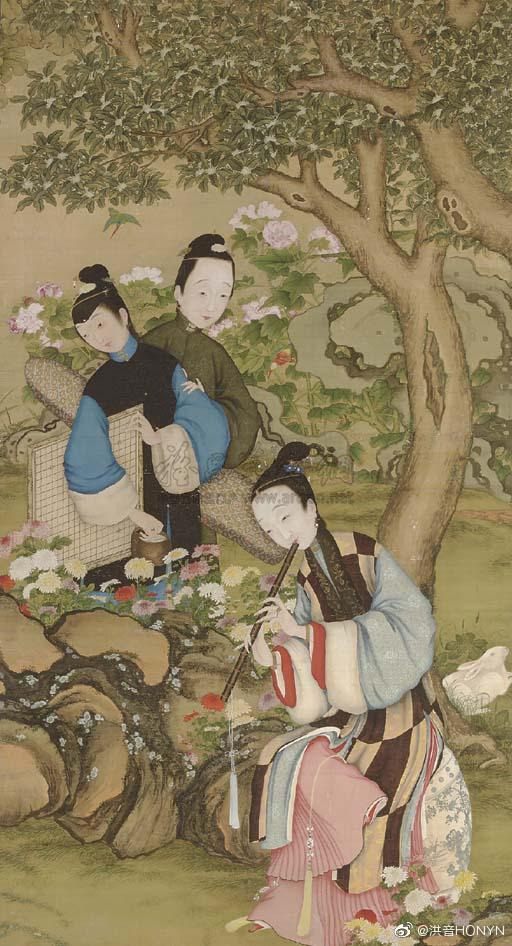
Early Qianlong era painting showing a lady in shuitianyi.
Returning to the character designs, the lady to the top left seems to be wearing something more akin to early Qing ceremonial dress or theater costumes than everyday Ming attire. The giant cloud collar plus the skirt with ribbons reads very much as theatrical, reminiscent of the 宫衣 gongyi. Her hairstyle also has not much historical basis, and is more likely taken from the guzhuang oeuvre.

Fantastical costume from an 18th century woodblock print.
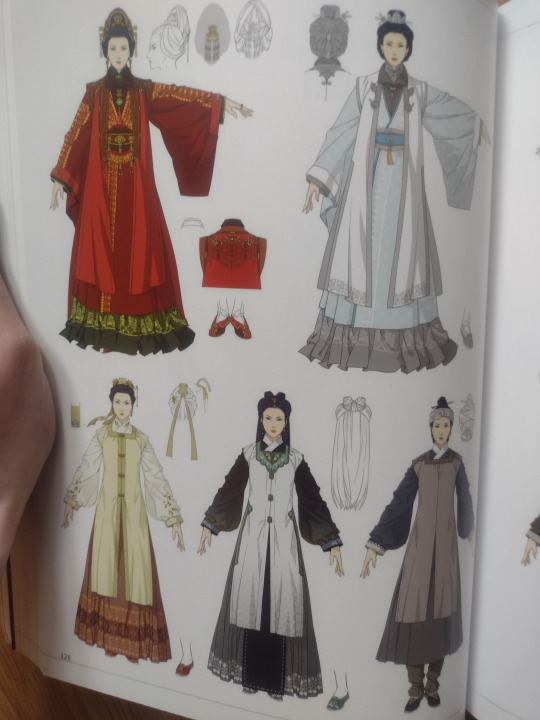
The two ladies at the top have a lot going on and they look kind of weird. The unclosed vest like garment looks to be a cursed combination of beizi and xiapei, and resembles neither. The interior garment is closed by a wide belt, which was not something that happened in womenswear during the Ming at all, and has its roots in guzhuang instead. Their outfits also mix cross collar garments with standing collar garments, which is anachronistic. They are wearing not one, but TWO garments with standing collars. People in the Ming were not SO fond of layering that they would turn down the collar on the outer robe just to reveal another one underneath... The hems of the skirts have an almost ruffled look; while many skirts in the Ming did not have pleats as sharp as the ones made by modern hanfu vendors, they’re still a far cry from this ruffled effect. The one thing I do appreciate is the decorative gold strip running down the sleeves of the red garment, that is something we do see in formal Ming dress. These two outfits are really overly exaggerated and pieced together from disparate elements found in various corners of the Ming’s existence.
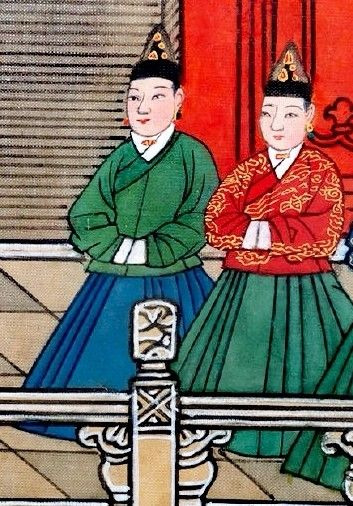
Snippet from 明宪宗元宵行乐图 showing gold decorative strip on sleeves, 1485.
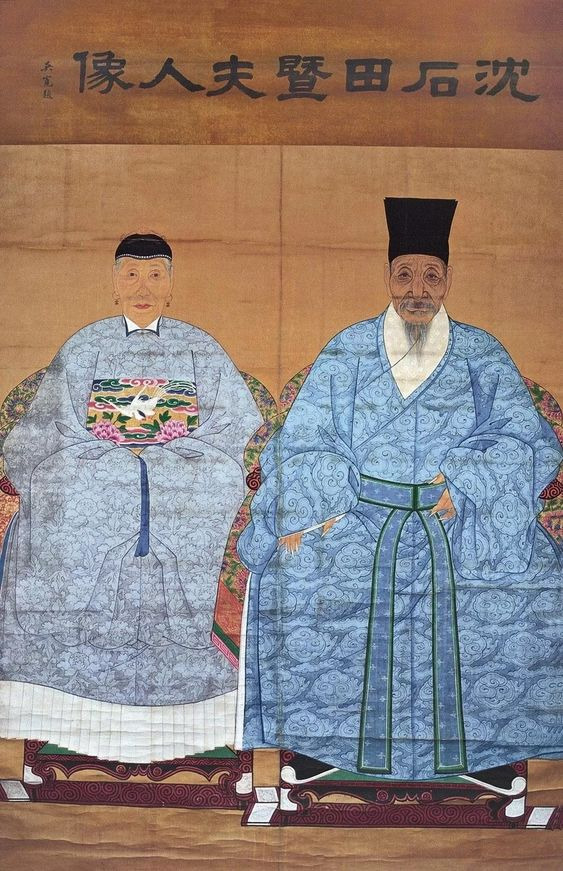
Late Ming portrait showing folded standing collar.
The girls in the bottom row are all wearing some version of the 比甲 bijia, which was associated with younger women and servants, so I think that’s a nice touch. Bijia usually had short or no sleeves, a square neckline and closes down the front with metal or cloth buttons.

I’m less knowledgeable about menswear so I won’t comment as much, but I think the problem of sleeve length carried over here as well. The general fit and silhouette is a bit too tight and not generous enough, considering how large and spacious Ming garments usually were. I do like that some male characters are wearing hats and headdresses, as historically most if not all men in the Ming covered their heads. The accuracy of the specific hats probably leaves much to be desired. The loose collar fit of the bottom row seems a bit odd, as Ming Dynasty robes with cross collars closed very tightly around the neck and wouldn’t allow so much of the inner layer to show. The guy at the top right is wearing a garment similar to the bijia (which was allegedly of menswear origin), commonly seen in military dress.

Ming style cross collar men’s robe.

Portrait of Emperor Xuande (?) in military dress, early 15th century.
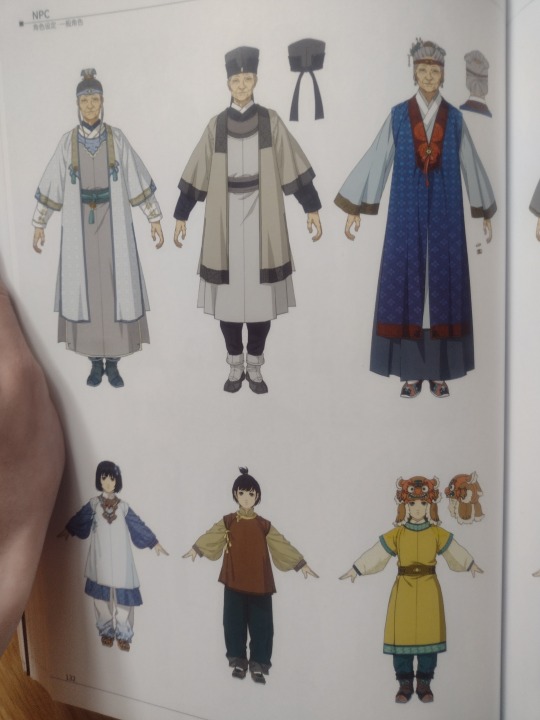
The outfits in the top row remind me more of childhood guzhuang dramas than anything from history to be honest, the wide belt and the wide trimming on the round collar robe are common features of guzhuang and very inaccurate. The headbands worn by the old ladies are reminiscent of 抹额 mo’e from the late 17th and early 18th centuries (again Qing Dynasty). The pairing of what seems to be a beizi with cross collar garments is anachronistic, again. I know nothing about children’s clothing so no comments.
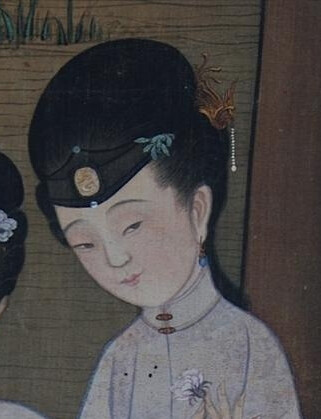
Snippet of a late 17th century (Kangxi era) painting showing mo’e.
Overall, I think the designers actually went and looked for information about Ming Dynasty dress and incorporated many elements of it into their designs, but in many places they fell flat because of either the dominance of guzhuang in costume design, over-reliance on older, antiquated literature or the inability (or unwillingness) to differentiate between different eras within the Ming, creating some very interesting fusions and some very cursed ones. The moments where their sources of inspiration skew toward the Qing are likely not intended, I think the creators were indeed trying to go for a Ming aesthetic but, because of the prevalence of 18th century erasure and appropriation in both academic and popular fashion history discussions, they simply didn’t recognize them as Qing. I do think it’s great that game designers are actively trying to depart from the guzhuang canon and create something new and interesting by incorporating actual historical dress, probably in no small part because they wanted to appeal to the popularity of hanfu among younger demographics. If they were more attentive to the details and silhouette I’m sure we’d see fabulous results.
#hanfu#ming dynasty#qing dynasty#18th century erasure#14th century#15th century#16th century#17th century#18th century#video games#costume analysis#古剑奇谭3
143 notes
·
View notes
Text
youtube
Watch the American Climate Leadership Awards 2024 now: https://youtu.be/bWiW4Rp8vF0?feature=shared
The American Climate Leadership Awards 2024 broadcast recording is now available on ecoAmerica's YouTube channel for viewers to be inspired by active climate leaders. Watch to find out which finalist received the $50,000 grand prize! Hosted by Vanessa Hauc and featuring Bill McKibben and Katharine Hayhoe!
#ACLA24#ACLA24Leaders#youtube#youtube video#climate leaders#climate solutions#climate action#climate and environment#climate#climate change#climate and health#climate blog#climate justice#climate news#weather and climate#environmental news#environment#environmental awareness#environment and health#environmental#environmental issues#environmental justice#environment protection#environmental health#Youtube
7K notes
·
View notes
Text
An argument I’ve seen come up within the OFMD fandom is that the characters shouldn’t use sexuality labels because they didn’t exist in the 18th century. But the thing is that they did exist in the 18th century. The concept that they didn’t is a myth perpetuated by the erasure of queer history. Yes a lot of our words didn’t exist or weren't used in the same way during the period (gay, bisexual, homosexual) and many 18th century sexuality labels have gone out of style (molly, tommy, sapphist) but some we still use (sapphic, lesbian). But also OFMD is overflowing with anachronisms so personally I don’t think Lucius saying he's gay would be more historically inaccurate than Olu’s crocs or Stede reading Pinocchio. I would like it if they used period language for the characters sexuality, if only so we can squash this myth that such language didn’t exist.
#ofmd#our flag means death#like instead of arguing over whether or not Lucius Spriggs can call himself gay we should be debating what his maiden name is#look Lucius seems like the type to be involved in molly culture
50 notes
·
View notes
Photo
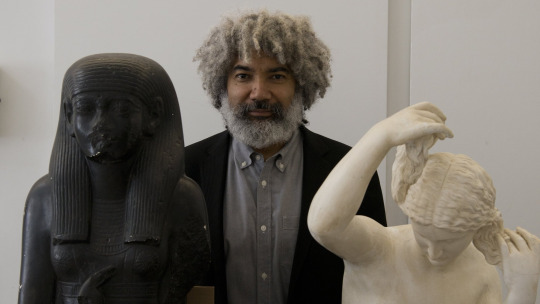
[...] «My chandeliers have become a vehicle for embodying things that are as complex as Othello himself. Most are a meditation on death, on blackness, on beauty.»
For Wilson’s exhibition, Speak of Me as I Am at the Venice Biennale, he investigated the history of Venice’s African population, fully immersing himself in the study of how Africans were depicted in 17th and 18th century Venetian paintings and decorative arts. Using phrases from Shakespeare’s Othello to title his first as well as most subsequent chandeliers, Wilson created Speak of Me as I Am: Chandelier Mori in Murano in the traditional Rezzonico style. Made in black glass, it is the first black chandelier ever to be created in the history of Venetian glassmaking. Wilson’s chandeliers utilize the seductive beauty of Venetian craftsmanship while simultaneously subverting assumptions of a homogenous European culture.
Continuing to expand on this body of work, Wilson made The Way the Moon’s in Love with the Dark for his installation Afro Kismet, which was exhibited at the Pera Museum in the Istanbul Biennial in 2017. Combining black Murano glass with traditional metal and glass elements of Ottoman chandeliers, this work underscores the centuries long and complicated relationship between Venice and Istanbul, two cultural crossroads whose expansive empires grew based on their strong and beneficial trading partnership. The title of the piece is a quote from the work of Alexander Pushkin, whose great grandfather was African and is believed to have passed through Istanbul before becoming part of the Imperial Household in Moscow and a general in the Russian Army.
Throughout his career, Wilson has challenged assumptions about race and museum display by masterfully juxtaposing and reframing artworks in opposition to simple objects. His work melds cultural symbols and unconventional materials, raising questions about erasure and exclusion in society. With the creation of these ornate sculptures, Wilson highlights the long-ignored presence of communities of African descent in Western culture. The chandeliers exemplify his practice—making something new while shedding light on a history that has been underrepresented.
Fred Wilson: Chandeliers will be on view from September 14 through October 12, 2019 at 540 West 25th Street. Next year, Afro Kismet will be exhibited at the Gibbes Museum of Art opening May 5, 2020 in conjunction with the Spoleto Festival USA. Wilson has been invited to participate in Dak’Art, the biennial in Dakar, Senegal, also opening May 2020.
#art#Fred Wilson#United States#glass sculpture#Speak of Me As I Am#Venice Biennale#17th century#18th century#Venice#Italian art#William Shakespeare#Othello#Speak of Me As I Am: Chandelier Mori#Murano glass#Rezzonico style#glassmaking#Afro Kismet#Pera Museum#Istanbul Biennal#2019#2017#2010s#Alexander Pushkin#Italian history#Russian history#representation#history#PACE Gallery#Dak'Art#Dakar
1 note
·
View note
Text
Movie Preview: A "Bridgerton" take on Austenland --"Mr. Malcolm's List"
Movie Preview: A “Bridgerton” take on Austenland –“Mr. Malcolm’s List”
By “Bridgerton” I mean the color blind casting that compensates for history and literature’s erasure of people of color from the Napoleonic Era and Britain on the cusp of the 18th century.
The Shonda Rhimes sex and plenty of it element may be missing. It’s ever so PG.
Freida Pinto, Sope Dirisu, Naoko Mori, Divian Ladwa and Theo James are among the players of many races who tell this story.
View On WordPress
0 notes
Photo

cusp, erasure from the preface of Pomona Herefordiensis
#spilled ink#inkstain#poets on tumblr#erasure poetry#found poetry#poetry#2021#not me being sick again as i make more erasures from this...#have i been cursed by 18th century botanists
24 notes
·
View notes
Note
Wizard! The Grand Chieftain demands to know, what is "Tartaria"?
From Wikipedia:
“Tartary (Latin: Tartaria) or Great Tartary (Latin: Tartaria Magna) was a historical region in Asia located between the Caspian Sea-Ural Mountains and the Pacific Ocean. Tartary was a blanket term used by Europeans for the areas of Central Asia, North Asia, and East Asia unknown to European geography. It encompassed the vast region of the Pontic-Caspian steppe, the Volga-Urals, the Caucasus, Siberia, Inner Asia, Mongolia and Manchuria.
Knowledge of Manchuria, Siberia and Central Asia in Europe prior to the 18th century was limited. The entire area was known simply as “Tartary” and its inhabitants “Tartars”. In the Early modern period, as understanding of the geography increased, Europeans began to subdivide Tartary into sections with prefixes denoting the name of the ruling power or the geographical location. Thus, Siberia was Great Tartary or Russian Tartary, the Crimean Khanate was Little Tartary, Manchuria was Chinese Tartary, and western Central Asia (prior to becoming Russian Central Asia) was known as Independent Tartary.”
What this means for conspiracy history is a different deal entirely.
There has been a recent resurgence in the idea that somewhere around 1000 years ago, there existed a large empire that spanned eastern Europe to the pacific ocean, but the existence of such an empire was erased from history by a shadowy group for unknown reasons.
Reasoning for the erasure of the Lost Empire of Tartaria has been attributed to anything from the ordinary Vile Antisemitsm to the more exotic "aliens did it." Conspiracies around the lost empire of Tartaria generally center around ideas of "lost technology," playing with the idea that the empire of Tartaria was a technologically advanced civilization with access to things like electricity and cloning as far back as the year 1200. Its popular among the "Alt-Science" branches of conspiracy lore that concern themselves with Aetherial Wind and Scalar Wave Communicators. They believe that Tartaria was conquered and their technology plundered by the shadowy victors, to be sold slowly to the rest of the world over the course of centuries.
Evidence in the minds of believers stems from some architectural similarities among buildings in the region that are, in reality, simply evidence that Alexander the great once had an empire there. Some also cite a particular declassified CIA report on USSR cultural revisionism in relation to early russian political relations with the Tartar people. Which is interesting, but there is no evidence to support the idea of a Lost Empire of this magnitude.
153 notes
·
View notes